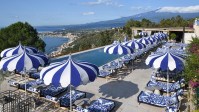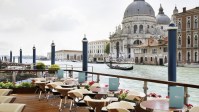What’s not to love about the boot-shaped Mediterranean country of Italy? Located in Southern Europe, Italy received 64 million tourists in 2019, making is the fifth most visited country in the world (after France, Spain, the USA and China). Travelers mainly visit Italy for its rich culture, world-class cuisine, passionate people, trendy fashion, ancient monuments, and picturesque villages. Besides its art treasures, Italy also features magnificent landscapes, which include spectacular coastlines, Alpine lakes and breathtaking mountains. The country is also home to the greatest number of UNESCO World Heritage Sites in the world. From the Italian Riviera and Grand Canal of Venice in the North to the breathtaking Amalfi Coast and Pompeii ruins in the South, Italy offers something for everyone.
Get the most out of your (luxury) trip to Italy with my travel guide. Find out more about:
- Best time to visit
- How to get there
- Travel requirements
- Getting around
- Inspiration, highlights, & travel tips
- Suggested itineraries
- Recommended luxury hotels (+ reviews)
BEST TIME TO VISIT – ITALY TRAVEL GUIDE
The best time to visit Italy are the months of May, June, and September. Compared to the peak summer months of July and August, these months offer more comfortable temperatures and there are fewer crowds (except around Easter). The country experiences four classic seasons per year, although there is a marked difference between the wetter, cooler North and the drier, warmer South. The rainiest months pretty much everywhere are usually October and November.
- Spring (April-June): temperatures start to warm up, although it’s still advisable to wear layers in case of colder spells. It’s a fantastic time to go to Italy for most travel interests and destinations. Spring makes up part of the shoulder season, lying just before the busy peak season.
- Summer (July & August): the heat can be grueling, particularly in the South. August is also when many Italians take their summer vacations, so big cities tend to be quiet (with discounted hotel prices), while beach and mountain resorts are jammed (with higher hotel prices).
- Fall (September – November): temperatures cool down gradually, although September is usually still very pleasant. Expect crisp fall leaves and some sunnier days, but plan for wet weather too. Fall carries many of the same benefits as spring, but with slightly less predictable weather.
- Winter: temperatures in the South remain mild in winter, while Northern Italy is normally wet and cold. Winter in the Italian Alps is fantastic though for skiing and snowboarding, but the ski resorts do get crowded so book early.
HOW TO GET THERE – ITALY TRAVEL GUIDE
Travelers wishing to visit Italy can use a bus, train, plane, or boat to get there. Most tourists arrive by plane though, often landing in Rome’s Leonardo da Vinci–Fiumicino Airport, the country’s busiest airport. This is the preferred point of entry in Italy when you want to visit Rome, or tour the entire country. Click here for a continuously updated list of airlines that offer direct flights to Rome.
Although Rome is the main getaway for most visitors to Italy, it’s often easier and cheaper to fly directly to/from one of the country’s other airports. It can also save you a lot of time to book a multi-city ticket, hereby arriving in one airport and leaving from another (for example fly in via Milan in the north and fly out via Naples in the south). The following airports are of interest for most tourist itineraries:
- Milan Malpenza Airport (north) is the largest international airport in the Milan metropolitan area in northern Italy (and also the main getaway to the Italian Lakes). Click here for a continuously updated list of airlines that offer direct flights to Milan.
- Venice Marco Polo airport (north) is the international airport of Venice. It offers flights to many European metropolitan areas as well as some partly seasonal long-haul routes to the United States, Canada, South Korea and the Middle East. Click here for a continuously updated list of airlines that offer direct flights to Venice.
- Naples Airport (south) is the international airport serving Naples and the Southern Italian region of Campania (which is also home to the Amalfi Coast). Click here for a continuously updated list of airlines that offer direct flights to Naples.
- Catania Airport (Sicily), also known as Vincenzo Bellini Airport, is the main getaway to Sicily and the the sixth busiest in Italy. Click here for a continuously updated list of airlines that offer direct flights to Catania.
Before you buy your plane ticket to Italy, consider reading my tips & tricks for buying the cheapest plane ticket so that you can save a few bucks.
TRAVEL REQUIREMENTS – ITALY TRAVEL GUIDE
Requirements for entry into Italy differ from country to country, and are subject to change. Prior to departure, always check with your government and your nearest Italian embassy or consulate what documents you need for travel to Greece.
- Citizens of the European Union are required to present a valid ID for entry into Italy.
- Citizens of Australia, Canada, New Zealand, South Africa, the United States, and almost all non-E.U. countries are required to have a valid passport valid for at least 90 days beyond the intended date of departure.
- For stays longer than 90 days, all non-E.U. citizens will need a visa.
Make sure you read my 10 tips to plan a worry-free trip.
GETTING AROUND – ITALY TRAVEL GUIDE
Once in Italy, you’ll have a good choice of affordable and efficient transport options:
- To best way to get around in Italy is by car. All major car rental agencies have offices in the main cities and airports. To rent a car in Italy, you must be at least 20 years old and have a valid driver’s license. Overall, renting a car in Italy is more expensive than using the public transport (see below), unless you are traveling with a larger group. When driving in Italy , especially in the busy cities, you really do need to keep your nerve about you as the Italian style of driving is chaotic. Tip: on most motorways or autostrade (singular: autostrada) there is a toll to pay — cash or by credit card — but superstrade an other major national roads are free.
- Italy’s railway system is good and inexpensive. Owned by the state, it’s called Ferrovie dello Stato (abbreviated FS), but trains are operated under the brand name “Trenitalia”. Most trains carry first and second class. First class seats often recline, there are fewer seats per car, and there is more space for luggage. On some Premier Trains, the price of a first class ticket includes a meal. Second class accommodations are less expensive, but not as spacious, as there are more seats per car. Seat reservation is now compulsory on faster trains ( i.e. Eurostar, EuroStarCity, and InterCity). On other, slower categories of trains (Regionale, Suburbano) it is not possible to reserve seats. To book your train ticket online, visit the Trenitalia website.
- If you are travelling around Italy by train, it is more than likely you will need to use a bus at some point. Nearly all places are connected by some kind of bus service, but in remote towns and villages schedules can be sketchy and are reduced, or even non-existent, at weekends. Bus terminals (autostazione) are often conveniently located next to the train station. In smaller towns and villages, most buses pull in at the central piazza.
- Depending on where you’re traveling to, it may be worth considering travelling around Italy by plane. These can sometimes be cheaper and quicker than traveling by train. Budget airlines open and close every season and there are often special deals being advertised. You can save by shopping around and, as always, booking as far in advance as you can. Tickets can be booked directly on the airlines’ websites:
INSPIRATION, HIGHLIGHTS, & TRAVEL TIPS – ITALY TRAVEL GUIDE
There are so many reasons why you should put Italy on top of your bucket list and visit the country at least once during your lifetime. Here are just some of Italy’s highlights:
- Touring historic cities like Rome, Florence and Venice
- Hiking in the Dolomites
- Relaxing on the beaches of Sardinia and Sicily
- Exploring the Vatican
- Visiting the Amalfi Coast & Capri
- Getting lost in Tuscany’s villages and countryside
- Admiring the scenery of the Italian Lakes (e.g. Lake Como)
My following, in-depth articles may also inspire you and help you plan your holiday to Italy:
- Top 10 most beautiful villages in Italy
- Top 10 best things to see & do on the Amalfi Coast
- Tips & tricks for getting the best deal at a luxury hotel
- Tips & tricks for buying the cheapest plane ticket
SUGGESTED ITINERARIES – ITALY TRAVEL GUIDE
It’s impossible to suggest one itinerary for Italy, but based on my own frequent holidays in the country, I hereby share a schedule which is great if you want to take in the country’s highlights in three weeks:
- Days 1-2 (2 nights): land in Venice and explore the city
- Recommended hotel: Aman Venice
- Days 3-5 (3 nights): explore and hike in the Dolomites
- Recommended hotel: Forestis
- Days 6-9 (3 nights): relax on the shores of Lake Como
- Recommended hotel: Il Sereno
- Days 10-14 (4 nights): explore Florence and Tuscany’s countryside
- Recommended hotel: Four Seasons Florence
- Days 15-18 (3 nights): expore Rome & The Vatican
- Recommended hotel: Portrait Roma
- Days 19-24 (5 nights): explore the Amalfi Coast & Capri, and fly out of Naples
- Recommended hotel: Belmond Caruso
If you have more time, I suggest you also explore the country’s islands Sardinia or Sicily.
For the planning of your own travel itinerary in Italy, I highly recommend the excellent itineraries as provided by Frommers, The Lonely Planet and Rough Guides.
RECOMMENDED LUXURY HOTELS (+ REVIEWS)
Read my top 10 lists if you are eager to know how I rank Italy’s top hotels, based on my own experience:
- Top 10 most fabulous luxury hotels in Italy
- Top 10 most stunningly beautiful hotels on the Amalfi Coast
- Top 10 best hotels on the the Italian Lakes
Below, you find my reviews of hotels in Italy (with pros, cons, and tips to save money per hotel).
 Review: San Domenico Palace, Taormina, a Four Seasons Hotel (Sicily, Italy)
Review: San Domenico Palace, Taormina, a Four Seasons Hotel (Sicily, Italy) Review: Verdura Resort – A Rocco Forte Hotel (Sicily, Italy)
Review: Verdura Resort – A Rocco Forte Hotel (Sicily, Italy) Review: The St Regis Venice Hotel (Italy)
Review: The St Regis Venice Hotel (Italy) Review: Forestis Dolomites (Italy)
Review: Forestis Dolomites (Italy) Review of Lefay Resort & Spa Lake Garda (Italy)
Review of Lefay Resort & Spa Lake Garda (Italy) Review: Belmond Villa Sant’Andrea, Sicily (Italy)
Review: Belmond Villa Sant’Andrea, Sicily (Italy) Review: Belmond Grand Hotel Timeo (Taormina, Sicily)
Review: Belmond Grand Hotel Timeo (Taormina, Sicily) Review of Belmond Hotel Splendido, Portofino (Italy)
Review of Belmond Hotel Splendido, Portofino (Italy) Review of Grand Hotel Portovenere, Cinque Terre (Italy)
Review of Grand Hotel Portovenere, Cinque Terre (Italy) Review of Grand Hotel Tremezzo, Lake Como (Italy)
Review of Grand Hotel Tremezzo, Lake Como (Italy) Review: Il Sereno Lake Como (Italy)
Review: Il Sereno Lake Como (Italy) Review of Bellevue Hotel & Spa, Aosta Valley (Italian Alps)
Review of Bellevue Hotel & Spa, Aosta Valley (Italian Alps) Review of Hotel JK Place Capri (Capri Island, Italy)
Review of Hotel JK Place Capri (Capri Island, Italy) Review: Hotel Caesar Augustus (Capri, Italy)
Review: Hotel Caesar Augustus (Capri, Italy) Review: Mezzatorre Resort & Spa (Ischia Island, Italy)
Review: Mezzatorre Resort & Spa (Ischia Island, Italy) Review: Monastero Santa Rosa Hotel (Amalfi Coast, Italy)
Review: Monastero Santa Rosa Hotel (Amalfi Coast, Italy) Review: Belmond Hotel Caruso (Amalfi Coast, Italy)
Review: Belmond Hotel Caruso (Amalfi Coast, Italy) Review: Belmond Hotel Cipriani (Venice, Italy)
Review: Belmond Hotel Cipriani (Venice, Italy) Hotel review: The Gritti Palace, Venice (Italy)
Hotel review: The Gritti Palace, Venice (Italy) Review: San Clemente Palace Venice (Italy)
Review: San Clemente Palace Venice (Italy) Review: JW Marriott Venice Resort & Spa (Italy)
Review: JW Marriott Venice Resort & Spa (Italy) Review: Aman Venice (Italy)
Review: Aman Venice (Italy) Hotel review: Casa Angelina, Amalfi Coast (Italy)
Hotel review: Casa Angelina, Amalfi Coast (Italy)
*** Follow me on Instagram, Youtube, Twitter or Facebook for a daily moment of travel inspiration ***



CADA DIA ESTÁ MELHOR O BLOG.
Parabéns….
you are the best person in the world.
I’m always on the lookout for unique travel experiences, and this blog delivers! I appreciate how you go beyond the typical tourist spots and uncover hidden gems. Your recommendations for local activities, cultural events, and lesser-known attractions are priceless. Thank you for helping me discover new and exciting places!